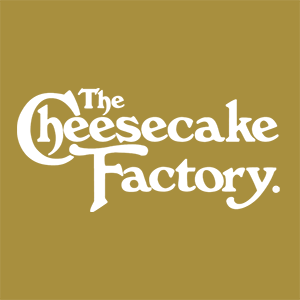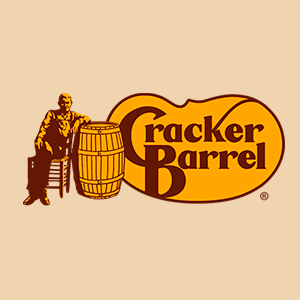
Texas Roadhouse (TXRH)
Texas Roadhouse catches our eye. Its exceptional revenue growth and returns on capital show it can expand quickly and profitably.― StockStory Analyst Team
1. News
2. Summary
Why Texas Roadhouse Is Interesting
With locations often featuring Western-inspired decor, Texas Roadhouse (NASDAQ:TXRH) is an American restaurant chain specializing in Southern-style cuisine and steaks.
- Stellar returns on capital showcase management’s ability to surface highly profitable business ventures
- Average same-store sales growth of 7.3% over the past two years indicates its restaurants are resonating with diners
- On a dimmer note, its gross margin of 17% is below its competitors, leaving less money for marketing and promotions


Texas Roadhouse shows some promise. This company is a good candidate for your watchlist.
Why Should You Watch Texas Roadhouse
High Quality
Investable
Underperform
Why Should You Watch Texas Roadhouse
Texas Roadhouse is trading at $168.05 per share, or 26.4x forward P/E. Texas Roadhouse’s valuation is around the peer average across the sector.
We’re adding this to our watchlist for the time being. It has potential, but we’re not buyers here and now. We prefer owning businesses with better fundamentals that trade at similar multiples.
3. Texas Roadhouse (TXRH) Research Report: Q3 CY2025 Update
Restaurant company Texas Roadhouse (NASDAQ:TXRH) reported Q3 CY2025 results topping the market’s revenue expectations, with sales up 12.8% year on year to $1.44 billion. Its GAAP profit of $1.25 per share was 3% below analysts’ consensus estimates.
Texas Roadhouse (TXRH) Q3 CY2025 Highlights:
- Revenue: $1.44 billion vs analyst estimates of $1.43 billion (12.8% year-on-year growth, 0.7% beat)
- EPS (GAAP): $1.25 vs analyst expectations of $1.29 (3% miss)
- Adjusted EBITDA: $149.6 million vs analyst estimates of $152.9 million (10.4% margin, 2.2% miss)
- Operating Margin: 6.7%, down from 8% in the same quarter last year
- Free Cash Flow Margin: 1%, down from 3.7% in the same quarter last year
- Locations: 806 at quarter end, up from 772 in the same quarter last year
- Same-Store Sales rose 6.3% year on year (8.2% in the same quarter last year)
- Market Capitalization: $11.01 billion
Company Overview
With locations often featuring Western-inspired decor, Texas Roadhouse (NASDAQ:TXRH) is an American restaurant chain specializing in Southern-style cuisine and steaks.
The company operates under the Texas Roadhouse, Bubba's 33, and Jaggers banners. Across its different brands, Texas Roadhouse is known for its hand-cut steaks, fall-off-the-bone ribs, made-from-scratch sides, and fresh-baked bread. Portions tend to be hearty, giving customers a good bang for their buck.
Texas Roadhouse primarily targets suburban and rural families seeking high-quality comfort food. Given the sit-down nature of the dining experience, the target customer will certainly spend more at Texas Roadhouse than a typical fast-food joint. However, prices also are meaningfully cheaper than fine dining experiences at stuffier “white tablecloth” establishments.
Restaurants are typically 6,000 to 7,500 square feet and located in high-traffic areas of suburban and rural cities and towns. Locations feature a rustic ambiance and sometimes feature nostalgic Southern memorabilia and even line dancing performances. Open kitchens allow customers to witness the preparation of their meals.
4. Sit-Down Dining
Sit-down restaurants offer a complete dining experience with table service. These establishments span various cuisines and are renowned for their warm hospitality and welcoming ambiance, making them perfect for family gatherings, special occasions, or simply unwinding. Their extensive menus range from appetizers to indulgent desserts and wines and cocktails. This space is extremely fragmented and competition includes everything from publicly-traded companies owning multiple chains to single-location mom-and-pop restaurants.
Multi-brand full-service restaurant competitors include Bloomin’ Brands (NASDAQ:BLMN), Brinker International (NYSE:EAT), Darden Restaurants (NYSE:DRI), Dine Brands (NYSE:DIN), and The Cheesecake Factory (NASDAQ:CAKE).
5. Revenue Growth
A company’s long-term performance is an indicator of its overall quality. Any business can experience short-term success, but top-performing ones enjoy sustained growth for years.
With $5.83 billion in revenue over the past 12 months, Texas Roadhouse is one of the larger restaurant chains in the industry and benefits from a well-known brand that influences consumer purchasing decisions.
As you can see below, Texas Roadhouse’s sales grew at an impressive 14.2% compounded annual growth rate over the last six years (we compare to 2019 to normalize for COVID-19 impacts) as it opened new restaurants and increased sales at existing, established dining locations.
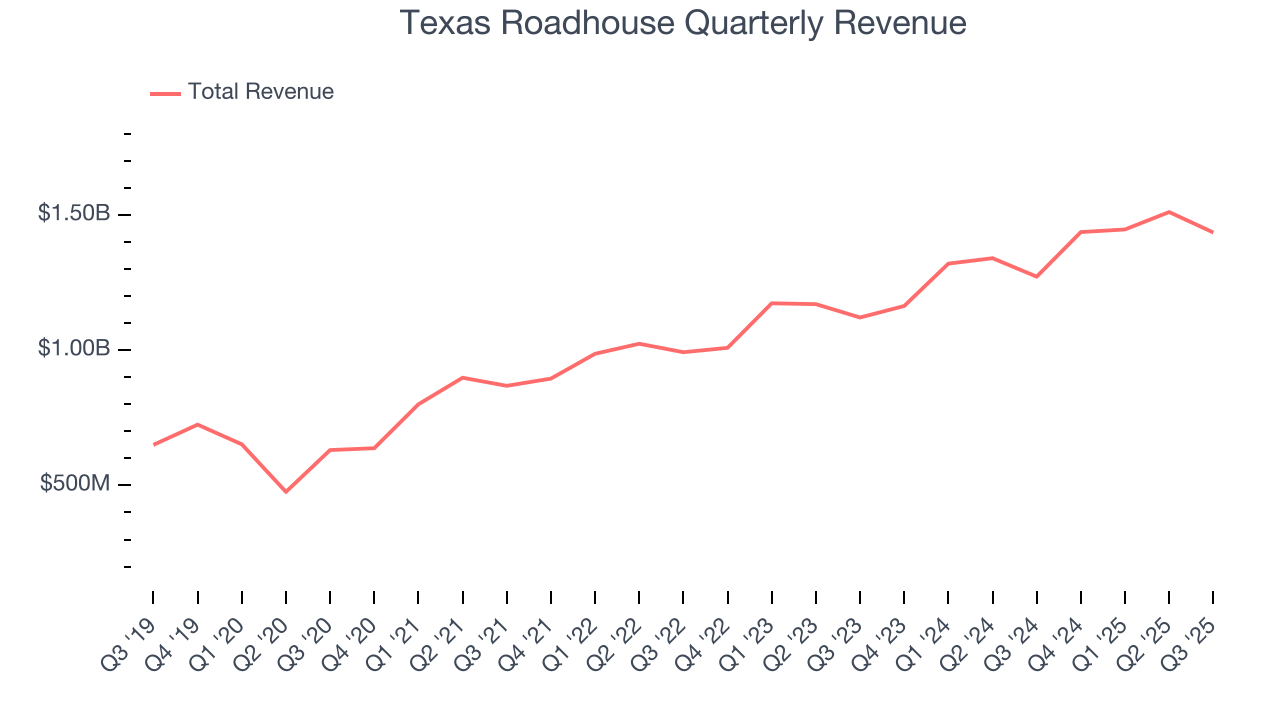
This quarter, Texas Roadhouse reported year-on-year revenue growth of 12.8%, and its $1.44 billion of revenue exceeded Wall Street’s estimates by 0.7%.
Looking ahead, sell-side analysts expect revenue to grow 8.4% over the next 12 months, a deceleration versus the last six years. Despite the slowdown, this projection is above average for the sector and indicates the market is baking in some success for its newer menu offerings.
6. Restaurant Performance
Number of Restaurants
Texas Roadhouse operated 806 locations in the latest quarter. It has opened new restaurants at a rapid clip over the last two years, averaging 6% annual growth, much faster than the broader restaurant sector.
When a chain opens new restaurants, it usually means it’s investing for growth because there’s healthy demand for its meals and there are markets where its concepts have few or no locations.
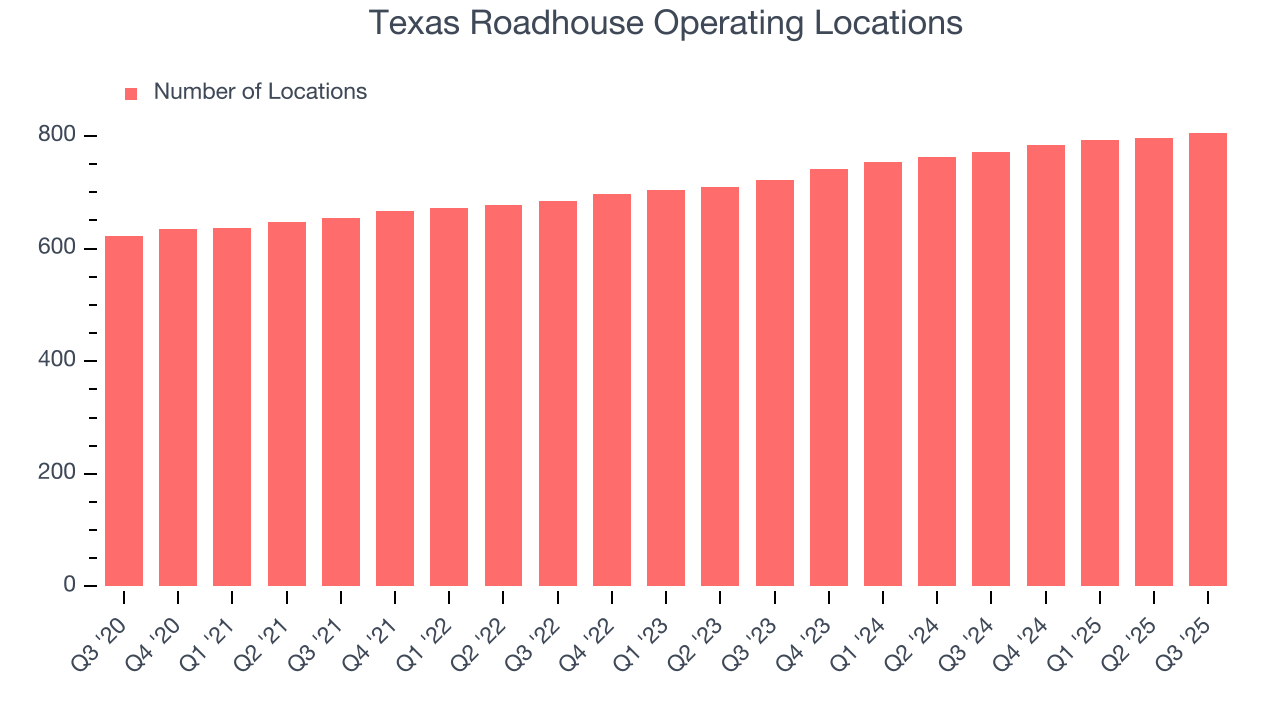
Same-Store Sales
The change in a company's restaurant base only tells one side of the story. The other is the performance of its existing locations, which informs management teams whether they should expand or downsize their physical footprints. Same-store sales is an industry measure of whether revenue is growing at those existing restaurants and is driven by customer visits (often called traffic) and the average spending per customer (ticket).
Texas Roadhouse has been one of the most successful restaurant chains over the last two years thanks to skyrocketing demand within its existing dining locations. On average, the company has posted exceptional year-on-year same-store sales growth of 7.3%. This performance suggests its rollout of new restaurants is beneficial for shareholders. We like this backdrop because it gives Texas Roadhouse multiple ways to win: revenue growth can come from new restaurants or increased foot traffic and higher sales per customer at existing locations.
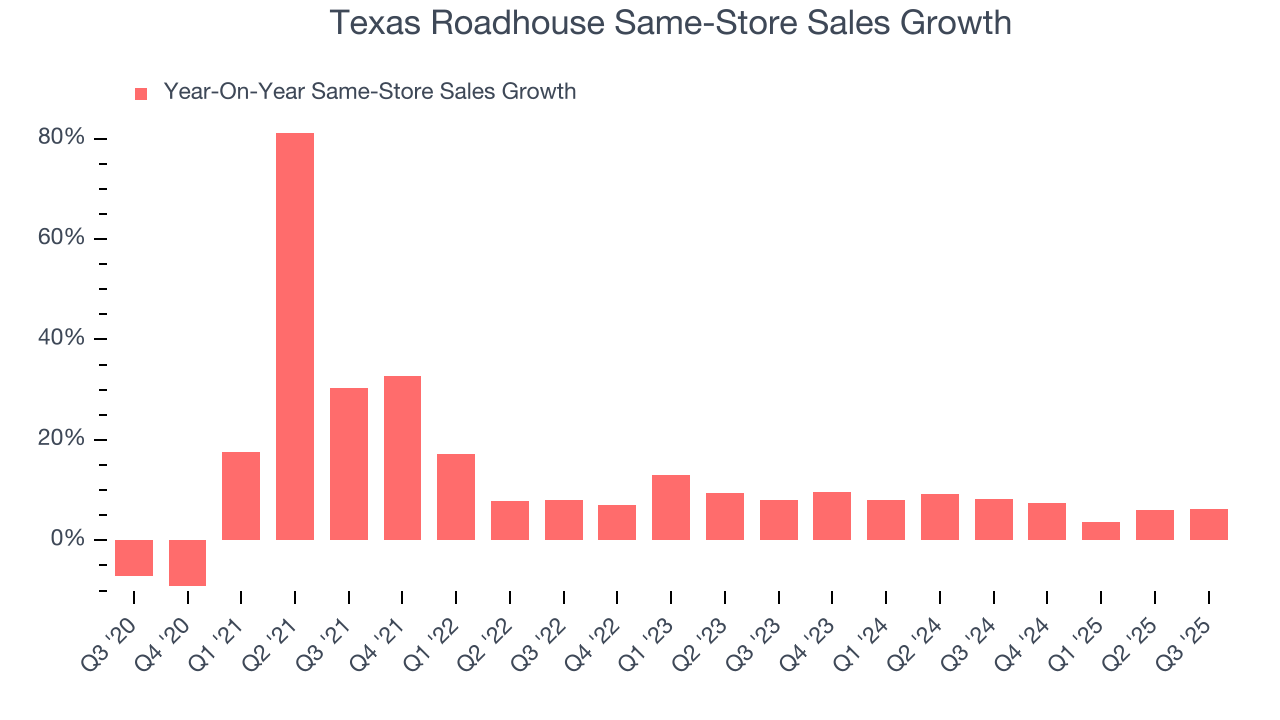
In the latest quarter, Texas Roadhouse’s same-store sales rose 6.3% year on year. This performance was more or less in line with its historical levels.
7. Gross Margin & Pricing Power
Texas Roadhouse has bad unit economics for a restaurant company, signaling it operates in a competitive market and has little room for error if demand unexpectedly falls. As you can see below, it averaged a 17% gross margin over the last two years. Said differently, Texas Roadhouse had to pay a chunky $83.04 to its suppliers for every $100 in revenue. 
This quarter, Texas Roadhouse’s gross profit margin was 14.7%, marking a 1.8 percentage point decrease from 16.5% in the same quarter last year. On a wider time horizon, the company’s full-year margin has remained steady over the past four quarters, suggesting its input costs (such as ingredients and transportation expenses) have been stable and it isn’t under pressure to lower prices.
8. Operating Margin
Operating margin is an important measure of profitability for restaurants as it accounts for all expenses keeping the business in motion, including food costs, wages, rent, advertising, and other administrative costs.
Texas Roadhouse’s operating margin might fluctuated slightly over the last 12 months but has generally stayed the same, averaging 8.9% over the last two years. This profitability was higher than the broader restaurant sector, showing it did a decent job managing its expenses. This is seen in its fast historical revenue growth, which is why we look at both data points together.
Analyzing the trend in its profitability, Texas Roadhouse’s operating margin might fluctuated slightly but has generally stayed the same over the last year. This raises questions about the company’s expense base because its revenue growth should have given it leverage on its fixed costs, resulting in better economies of scale and profitability.

This quarter, Texas Roadhouse generated an operating margin profit margin of 6.7%, down 1.3 percentage points year on year. Since Texas Roadhouse’s gross margin decreased more than its operating margin, we can assume its recent inefficiencies were driven more by weaker leverage on its cost of sales rather than increased marketing, and administrative overhead expenses.
9. Earnings Per Share
Revenue trends explain a company’s historical growth, but the long-term change in earnings per share (EPS) points to the profitability of that growth – for example, a company could inflate its sales through excessive spending on advertising and promotions.
Texas Roadhouse’s EPS grew at a solid 19.3% compounded annual growth rate over the last six years, higher than its 14.2% annualized revenue growth. However, this alone doesn’t tell us much about its business quality because its operating margin didn’t improve.

In Q3, Texas Roadhouse reported EPS of $1.25, down from $1.26 in the same quarter last year. This print missed analysts’ estimates, but we care more about long-term EPS growth than short-term movements. Over the next 12 months, Wall Street expects Texas Roadhouse’s full-year EPS of $6.55 to grow 9.4%.
10. Cash Is King
If you’ve followed StockStory for a while, you know we emphasize free cash flow. Why, you ask? We believe that in the end, cash is king, and you can’t use accounting profits to pay the bills.
Texas Roadhouse has shown impressive cash profitability, giving it the option to reinvest or return capital to investors. The company’s free cash flow margin averaged 6.2% over the last two years, better than the broader restaurant sector.
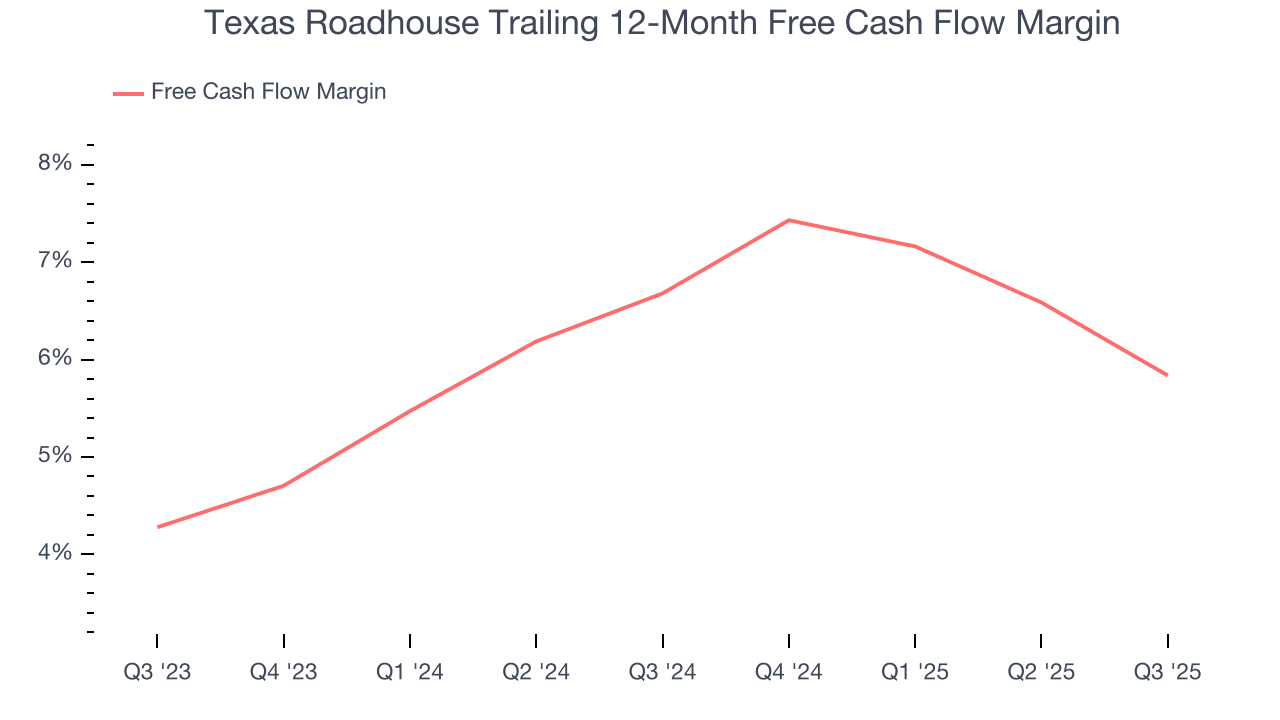
Texas Roadhouse’s free cash flow clocked in at $14.73 million in Q3, equivalent to a 1% margin. The company’s cash profitability regressed as it was 2.7 percentage points lower than in the same quarter last year, but we wouldn’t read too much into the short term because investment needs can be seasonal, causing temporary swings. Long-term trends trump fluctuations.
11. Return on Invested Capital (ROIC)
EPS and free cash flow tell us whether a company was profitable while growing its revenue. But was it capital-efficient? Enter ROIC, a metric showing how much operating profit a company generates relative to the money it has raised (debt and equity).
Texas Roadhouse’s five-year average ROIC was 20.5%, placing it among the best restaurant companies. This illustrates its management team’s ability to invest in highly profitable ventures and produce tangible results for shareholders.
12. Balance Sheet Assessment
Texas Roadhouse reported $108.2 million of cash and $903.8 million of debt on its balance sheet in the most recent quarter. As investors in high-quality companies, we primarily focus on two things: 1) that a company’s debt level isn’t too high and 2) that its interest payments are not excessively burdening the business.

With $718 million of EBITDA over the last 12 months, we view Texas Roadhouse’s 1.1× net-debt-to-EBITDA ratio as safe. We also see its $4.76 million of annual interest expenses as appropriate. The company’s profits give it plenty of breathing room, allowing it to continue investing in growth initiatives.
13. Key Takeaways from Texas Roadhouse’s Q3 Results
We enjoyed seeing Texas Roadhouse beat analysts’ same-store sales expectations this quarter. We were also happy its revenue narrowly outperformed Wall Street’s estimates. On the other hand, its EBITDA missed and its EPS fell short of Wall Street’s estimates. Zooming out, we think this was a mixed quarter. The stock remained flat at $161 immediately following the results.
14. Is Now The Time To Buy Texas Roadhouse?
Updated: December 3, 2025 at 9:44 PM EST
We think that the latest earnings result is only one piece of the bigger puzzle. If you’re deciding whether to own Texas Roadhouse, you should also grasp the company’s longer-term business quality and valuation.
There are definitely a lot of things to like about Texas Roadhouse. First off, its revenue growth was good over the last six years. And while its projected EPS for the next year is lacking, its marvelous same-store sales growth is on another level. On top of that, its new restaurant openings have increased its brand equity.
Texas Roadhouse’s P/E ratio based on the next 12 months is 26.4x. This valuation tells us it’s a bit of a market darling with a lot of good news priced in. This is a good one to add to your watchlist - there are better opportunities elsewhere at the moment.
Wall Street analysts have a consensus one-year price target of $189.08 on the company (compared to the current share price of $168.05).




